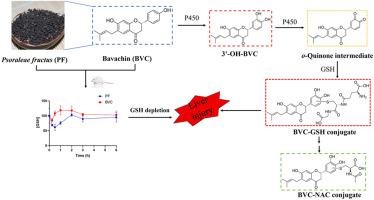CYP3A介导的小鼠巴伐青素代谢激活及细胞毒性研究。
IF 5.4
2区 医学
Q1 BIOCHEMISTRY & MOLECULAR BIOLOGY
引用次数: 0
摘要
巴伐辛(BVC)是一种类黄酮,在补骨脂果(PF)中发现,据报道,巴伐辛可引起各种不良反应,特别是肝毒性,如小鼠服用BVC后血清丙氨酸转氨酶和天冬氨酸转氨酶升高。然而,其肝毒性的机制尚不清楚。在谷胱甘肽(GSH)或n -乙酰半胱氨酸(NAC)存在下,BVC小鼠微粒体孵育期间,观察到一种氧化代谢物(M1)、一种谷胱甘肽偶联物(M2)和一种NAC偶联物(M3)。用BVC选择性氧化法成功合成了M1。类似的合成M1微粒体培养提供M2和M3。口服BVC后,观察到BVC小鼠胆道M2和尿液M3的存在。CYP3A作为主要酶参与了BVC的代谢激活。BVC的代谢激活包括BVC的羟基化和羟基化产物依次氧化为相应的邻醌衍生物。BVC对培养小鼠原代肝细胞有明显的细胞毒性,1-氨基苯并三唑和酮康唑预处理可降低肝细胞对BVC细胞毒性的敏感性。口服PF提取物可使小鼠肝脏GSH迅速下降,同时检测GSH偶联物M2。BVC, PF的主要成分,也被发现在短时间内消耗小鼠肝脏GSH。这一证据表明,BVC的代谢激活导致体内GSH的消耗,BVC有助于PF提取物引起的肝脏GSH的消耗。本文章由计算机程序翻译,如有差异,请以英文原文为准。

Metabolic activation and cytotoxicity of bavachin mediated by CYP3A in mice
Bavachin (BVC), a flavonoid, is found in Psoraleae fructus (PF) which has been reported to induce various adverse effects, particularly hepatotoxicity, such as increases of serum alanine transaminase (ALT) and aspartate transaminase (AST) in mice given BVC. However, the mechanisms underlying its hepatotoxicity remain unclear. During the incubation of mouse microsomes with BVC in the presence of glutathione (GSH) or N-acetylcysteine (NAC), one oxidative metabolite (M1), one GSH conjugate (M2), and one NAC conjugate (M3) were observed. M1 was successfully synthesized by selective oxidation of BVC. Similar microsomal incubations of synthetic M1 offered M2 and M3. Following oral administration of BVC, the presence of biliary M2 and urinary M3 was observed in mice given BVC. CYP3A identified as the major enzyme was involved in the metabolic activation of BVC. The metabolic activation of BVC involved hydroxylation of BVC and sequential oxidation of the hydroxylation product to the corresponding o-quinone derivative. BVC treatment resulted in significant cytotoxicity in cultured mouse primary hepatocytes, and pretreatment with 1-aminobenzotriazole and ketoconazole decreased the susceptibility of hepatocytes to the cytotoxicity of BVC. Oral administration of PF extract resulted in a quick decline in hepatic GSH, along with the detection of GSH conjugate M2, in mice. BVC, a principal component of PF, was also found to deplete hepatic GSH in mice over a brief period. This evidence suggests that metabolic activation of BVC leads to depletion of GSH in vivo and that BVC contributes to the depletion of hepatic GSH caused by PF extract.
求助全文
通过发布文献求助,成功后即可免费获取论文全文。
去求助
来源期刊
CiteScore
7.70
自引率
3.90%
发文量
410
审稿时长
36 days
期刊介绍:
Chemico-Biological Interactions publishes research reports and review articles that examine the molecular, cellular, and/or biochemical basis of toxicologically relevant outcomes. Special emphasis is placed on toxicological mechanisms associated with interactions between chemicals and biological systems. Outcomes may include all traditional endpoints caused by synthetic or naturally occurring chemicals, both in vivo and in vitro. Endpoints of interest include, but are not limited to carcinogenesis, mutagenesis, respiratory toxicology, neurotoxicology, reproductive and developmental toxicology, and immunotoxicology.

 求助内容:
求助内容: 应助结果提醒方式:
应助结果提醒方式:


